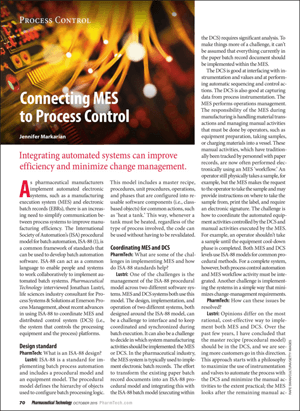For pharmaceutical and biotech manufacturers, the flow and capture of information is as important as the flow of the manufacturing process in readying products to release for sale.
 In a Pharmaceutical Technology magazine article, Connecting MES to Process Control, Emerson’s Jonathan Lustri is interviewed about advances in using the ISA-88 standard to coordinate manufacturing execution systems (MES) and distributed control systems (DCS).
In a Pharmaceutical Technology magazine article, Connecting MES to Process Control, Emerson’s Jonathan Lustri is interviewed about advances in using the ISA-88 standard to coordinate manufacturing execution systems (MES) and distributed control systems (DCS).
Jonathan describes what an ISA-88 design is about:
ISA-88 is a standard for implementing batch process automation and includes a procedural model and an equipment model. The procedural model defines the hierarchy of objects used to configure batch processing logic. This model includes a master recipe, procedures, unit procedures, operations, and phases that are configured into reusable software components (i.e., class-based objects) for common actions, such as ‘heat a tank.’
The challenge in this design is that:
MES and DCS systems both use this model. The design, implementation, and operation of two different systems, both designed around the ISA-88 model, can be a challenge to interface and to keep coordinated and synchronized during batch execution. It can also be a challenge to decide in which system manufacturing activities should be implemented: the MES or DCS. In the pharmaceutical industry, the MES system is typically used to implement electronic batch records.
As pharmaceutical and biopharmaceutical manufacturers move away from paper-based batch records to improve operational efficiency, Jonathan explains that not everything done on paper should be implemented in the MES. It’s also very important that the automated activities under the control of the DCS be integrated with the manual activities, such as sample collection, be integrated and coordinated as part of an efficient workflow.
In designing where to implement the workflow, Jonathan believes:
…that the master recipe (procedural model) should be in the DCS, and we are seeing more customers go in this direction. This approach starts with a philosophy to maximize the use of instrumentation and valves to automate the process with the DCS and minimize the manual activities to the extent practical; the MES looks after the remaining manual activities.
Read the article for more and to see where Jonathan thinks that advances in the MES and DCS will occur.
You can also connect and interact with other pharmaceutical and biotech industry experts in the Life Sciences group in the Emerson Exchange 365 community.





